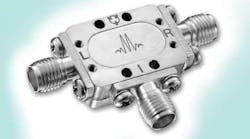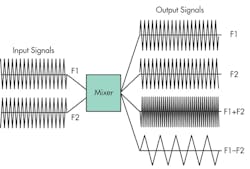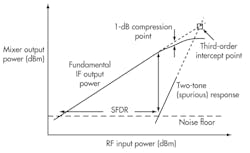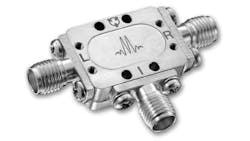This file type includes high resolution graphics and schematics when applicable.
While Reginald Fessenden worked for the U.S. Weather Bureau in the early 1900s, he was determined to advance radio principles to the point where a network of coastal radio stations could transmit weather information over long distances. Studiously working for his $3,000 a year, Fessenden invented a principle of combining two radio signals to form a reduced composite of the signals in the audible spectrum—a process known as “heterodyning.” Building on Fessenden’s work, Edwin Armstrong later developed the first super-heterodyne receiver.
Modern mixers have moved far beyond this heritage to multiply or divide RF signals well into the millimeter-wave range. Yet the advanced behavior of these mixers requires increasing complexity in an industry that demands never-ending performance enhancements.
Mixers are used throughout the RF industry wherever significant frequency translation is needed. Using the dynamics of a nonlinear node and clever circuitry, which forces some linear behavior from the mixing device, two input signals can be multiplied or divided (Fig. 1). Diodes, Schottky diodes, bipolar-junction transistors (BJTs), or field-effect transistors (FETs) can be used as nonlinear elements.
Creating an upconverted or downconverted output signal requires the use of a local-oscillator (LO) input signal, intermediate-frequency (IF) input/output signal, and an RF input/output signal. The most common mixers use the switching action of the LO to drive a nonlinear junction in and out of conduction, thereby clipping the RF signal. As no device is ideal, several unwanted frequency products are generated by the mixing action. One figure of merit for mixers reveals how well these products are suppressed. Other figures of merit include spurious-free dynamic range (SFDR), noise figure (NF), input third-order intercept point (IIP3), the 1-dB compression point, conversion gain, and isolation (Fig. 2).
Among the various types of mixers, there are two main categories: passive and active mixers. Passive, or current-commutating, mixers generally have higher 1-dB compression points, a lower NF, and a higher IIP3. Active mixers tend to have much lower power consumption and even a potential increase in conversion gain—although they trade off lower power for lower linearity. Both passive and active mixers can be divided into several classes: single-device, single-balanced, double-balanced, and triple-balanced (double-double-balanced mixer).
This file type includes high resolution graphics and schematics when applicable.
This file type includes high resolution graphics and schematics when applicable.
Single-device mixers use a nonlinear component for the mixing action. Often, they require injection filters, as they do not attenuate the LO signal in the output. The benefit of single-device mixers is that they are capable of reaching millimeter-wave frequencies. Using two nonlinear devices connected via a 180° or 90° hybrid can improve the isolation between the LO and output signal. The resulting device is called a single-balanced mixer. Balanced mixers tend to have lower frequency capability and require baluns. According to Christopher Marki, director of operations for Marki Microwave, “Mixer frequency coverage is [usually] governed by the balun. Magnetic baluns work very well below 3 GHz, and many companies make such mixers. Non-magnetic, or capacitive coupled, baluns are fantastic in 2-GHz and higher applications. Those baluns are [usually] limited to several octaves. Mixers have a sort of ‘gain/bandwidth’ product that is mostly related to baluns.”
Using a network of four nonlinear devices with multiple hybrids, baluns, or transformers produces a higher-performing mixer class, which are referred to as double-balanced mixers. The double-balanced mixer benefits from the rejection of spurious/intermodulation products, better isolation among all ports, and modulated noise rejection in the LO signal. Compared to single-device mixers, balanced mixers boast limited requirements for additional filters and generally broader bandwidth. Higher LO power is necessary for balanced mixer operation to avoid high conversion loss. Often, LO amplifiers are included in mixer designs for this reason.
Because the inclusion of an LO amplifier can add noise and proper matching between components and at the IF output is essential to avoid conversion loss and undesired harmonic increases, the higher required LO power is a necessary feature of the operation of balanced mixer classes. If the LO power drops below the recommended level, all of the mixer parameters will degrade. Such degradation is a non-predictable function of the diode characteristics, circuit tolerances, and temperature.
Industry demands for better mixer performance often require more advanced mixer classes. Marki says, “The crowded frequency spectrum puts a huge premium on ultra-linear analog hardware for everything from commercial use, high-end test equipment, and sophisticated electronic warfare. The name of the game is dynamic range. If you can make an efficient frequency converter that doesn’t add nonlinear distortion, you will win a lot of business.”
To meet these demands, the design figures of merit for linearity and SFDR must increase. The devices also need to operate with overlapping or near-overlapping input and output signals. Using an unbalanced mixer with various filters for increased isolation does not always provide the necessary frequency operation. In these cases, more advanced circuit typologies may be required.
This file type includes high resolution graphics and schematics when applicable.
This file type includes high resolution graphics and schematics when applicable.
For example, the triple-balanced mixer is the culmination of two double-balanced mixers combined using a push-pull drive configuration. These mixers can support overlapping RF, LO, and intermediate frequencies while flaunting the highest spurious noise suppression of the classes. The higher-bandwidth capabilities and low-conversion-loss aspects of the triple-balanced mixer are among its additional design advantages. Using near-ideal commutating switching techniques and internal feedback circuitry to enhance performance, triple-balanced mixers can be pushed to very high linear behavior.
Challenges of Discrete and Integrated Mixer Technology
Mixers are manufactured to many size, frequency, and power constraints. The two main styles of mixers are discrete (hybrid) and integrated (monolithic) mixers. Discrete mixers typically use silicon-based Schottky diodes, whereas integrated mixers use NPN transistors for active types and FETs for passive types. Discrete mixers can achieve a higher linearity response and lower NF response than active mixers. Yet they also are known for increased cost, a larger footprint, and often higher power requirements (Fig. 4).
Discrete mixers require matched diode structures and carefully chosen components. The demands for decreased size and lower-power operation translate into more challenging requirements for these mixers. Marki says, “Mixers that require magnetic baluns are still very large; our smallest is 0.32 in. on a side. These mixers use magnetic baluns that often dwarf the rest of the RF circuitry, and they are very tall. There is no clearly demonstrated and viable way to eliminate these ‘old school’ wire-wound ferrite cores from the assembly.” Minimizing component sizes to reduce the overall footprint generally requires a decrease in a device’s RF power, which impacts the response’s linearity.
Integrated mixers can be designed to high tolerances. Enabled by integrated matching techniques, such mixers may incur lower costs by taking advantage of silicon processes. As noted by Tom Schiltz, design section leader of high-frequency products for Linear Technology, “Advanced silicon-process technologies offer higher speed and a wider operating frequency. But they come at the expense of lower breakdown voltages, which can limit mixer IIP3 and input-signal handling capability.” He also warns that “integrated mixers are limited by the parasitics of packaging technologies available today and the electrostatic-discharge (ESD) circuits that are required to protect the device.”
When it comes to limitations in active mixers, another consideration is the size of the baluns used in the designs. Baluns require significant space on chip. Off-chip baluns may be used, but they increase the overall mixer footprint while adding parasitics to the design. These factors lead to double-balanced mixers being the popular choice for integrated mixers. After all, the footprint and performance drawbacks of on-chip baluns make triple-balance implementations challenging for low frequencies.
Clearly, the increased performance requirements for RF/microwave devices lie heavily on the side of mixer manufacturers and designers. Schiltz notes, “In RF systems, the mixer is usually the limiting factor for system linearity. Furthermore, mixers produce undesired mixing products that must be filtered and increase the system noise floor, which limits receiver sensitivity.”
Linearity is one of the major enabling factors for higher data rates for communications technology, increased accuracy for test and measurement applications, and reliability for electronic-warfare and military applications. As such, the pressure is on to push the boundaries of mixer technology.
For sub-6-GHz RF mixers, tunability features are beginning to emerge that limit the effects of process, temperature, power, and frequency variations. These techniques use toggle pins enabled by DC control in critical locations throughout the mixer circuit. Software-control and feedback methods may be used to enhance the linearity or sideband suppression of the next generation of RF mixers. Marki says, “The reconfiguration of 6-GHz and higher mixers is not supported in a meaningful way yet. But I think some microwave and millimeter-wave mixers may support this in the future.”
Above 10 GHz, however, there are additional challenges in producing commutating LO waveforms. Yet mixers are steadily breaking new ground in terms of performance. To gauge cutting-edge performance today, Marki shared a figure of merit: If a 10+-GHz mixer has a 30-dBm IIP3 with conversion loss of 8 dB, it is on the upper edge of modern mixer performance.
This file type includes high resolution graphics and schematics when applicable.





